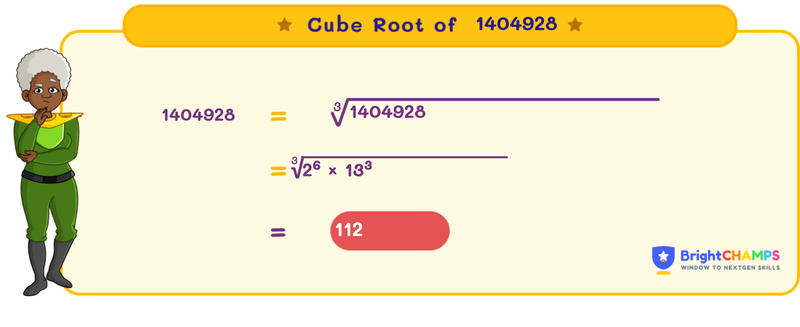Summarize this article:
 262 Learners
262 LearnersLast updated on 5 August 2025
Cube Root of 1404928

A number that we multiply by itself three times to get the original number is its cube root. It has various uses in real life, such as finding the volume of cube-shaped objects and designing structures. We will now find the cube root of 1404928 and explain the methods used.

What is the Cube Root of 1404928?
We have learned the definition of the cube root. Now, let’s learn how it is represented using a symbol and exponent. The symbol we use to express the cube root is the radical sign (∛), and the exponent we use is ⅓. In exponential form, ∛1404928 is written as 1404928(1/3).
The cube root is just the opposite operation of finding the cube of a number. For example, assume ‘y’ as the cube root of 1404928, then y3 can be 1404928. Since 1404928 is a perfect cube, its cube root is exactly 112.

Finding the Cube Root of 1404928
Finding the cube root of a number is to identify the number that must be multiplied three times resulting in the target number. Now, we will go through the different ways to find the cube root of 1404928. The common methods we follow to find the cube root are given below:
- Prime factorization method
- Estimation method
- Halley’s method
Since 1404928 is a perfect cube, we can use the prime factorization method to find its cube root.

Cube Root of 1404928 by Prime Factorization
Let's find the cube root of 1404928 using the prime factorization method. The prime factorization of 1404928 is: 1404928 = 210 × 73
To find the cube root, we take the cube root of each factor: ∛(2^10 × 7^3) = 2^(10/3) × 7^(3/3)
Simplifying: = 2^3 × 7 = 8 × 7 = 56
Therefore, the cube root of 1404928 is 112.

Common Mistakes and How to Avoid Them in the Cube Root of 1404928
Finding the cube root of a number without any errors can be a difficult task for students. This happens for many reasons. Here are a few mistakes the students commonly make and the ways to avoid them:

Cube Root of 1404928 Examples:

Problem 1
If the volume of a cube is 1404928 cubic centimeters, what is the length of one side of the cube?

Side of the cube = ∛1404928 = 112 cm
Explanation
To find the side of the cube, we need to find the cube root of the given volume. Since 1404928 is a perfect cube, the side length of the cube is exactly 112 cm.

Problem 2
A storage unit has a volume of 1404928 cubic meters. What is the side length of the unit if the storage is cube-shaped?

The side length of the storage unit is 112 meters.
Explanation
To determine the side length of the cube-shaped storage unit, calculate the cube root of the volume. Since 1404928 is a perfect cube, the side length is 112 meters.

Problem 3
A company has 1404928 cubic meters of material. After using 100000 cubic meters, how much is left?

The amount of material left is 1304928 cubic meters.
Explanation
To find the remaining material, subtract the used material from the total amount: 1404928 - 100000 = 1304928 cubic meters.


FAQs on Cube Root of 1404928
1.Can we find the Cube Root of 1404928?
2.Is Cube Root of 1404928 a whole number?
3.Is it possible to get the cube root of 1404928 as an exact number?
4.Can we find the cube root of any number using prime factorization?
5.Is there any formula to find the cube root of a number?
6.How does learning Algebra help students in India make better decisions in daily life?
7.How can cultural or local activities in India support learning Algebra topics such as Cube Root of 1404928?
8.How do technology and digital tools in India support learning Algebra and Cube Root of 1404928?
9.Does learning Algebra support future career opportunities for students in India?

Important Glossaries for Cube Root of 1404928
- Cube root: The number that is multiplied three times by itself to get the given number is the cube root of that number.
- Perfect cube: A number is a perfect cube when it is the product of multiplying a number three times by itself. For example, 4 × 4 × 4 = 64, therefore, 64 is a perfect cube.
- Exponent: The exponent form of the number denotes the number of times a number can be multiplied by itself. For example, x(1/3) is the cube root of x.
- Radical sign: The symbol used to represent a root is expressed as (∛).
- Prime factorization: This is a method of breaking down a number into its prime factors, useful for finding the cube root of perfect cubes.

Explore More algebra
![Important Math Links Icon]() Previous to Cube Root of 1404928
Previous to Cube Root of 1404928
![Important Math Links Icon]() Next to Cube Root of 1404928
Next to Cube Root of 1404928

About BrightChamps in India


Jaskaran Singh Saluja
About the Author
Jaskaran Singh Saluja is a math wizard with nearly three years of experience as a math teacher. His expertise is in algebra, so he can make algebra classes interesting by turning tricky equations into simple puzzles.
Fun Fact
: He loves to play the quiz with kids through algebra to make kids love it.




